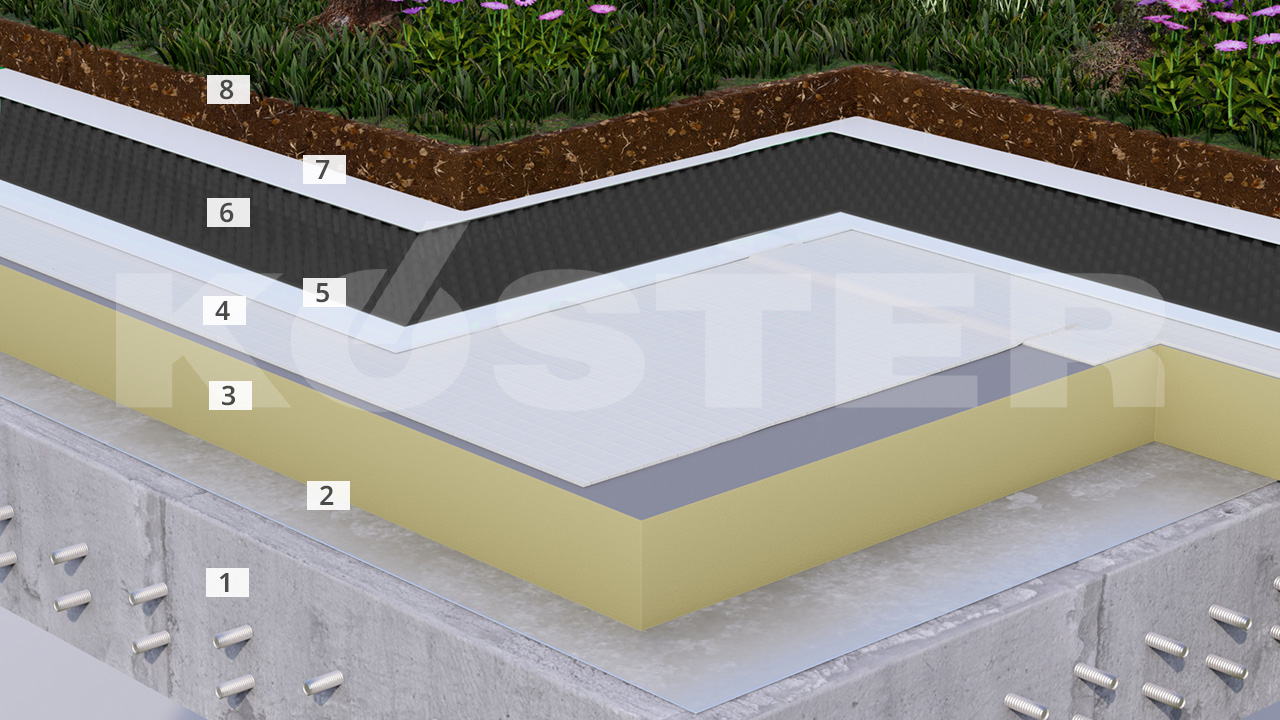Tage er på grund af deres eksponerede position udsat for betydelige temperatur- & vejrbetingede belastninger, hvor revnedannelse på grund af spændinger i tætningen kan være en konsekvens. Efterfølgende sikre tætninger er påkrævet. Det er af afgørende betydning at anvende produkter med stor elasticitet og høj UV-bestandighed.

1 Undergrund
KÖSTER
2 Fugtspærre
KÖSTER Fugtbarriere LFL
3 Isolering
KÖSTER
4 KÖSTER TPO Membran
KÖSTER ECB 2.0
KÖSTER TPO 1.5
KÖSTER TPO 1.8
KÖSTER TPO 2.0
KÖSTER TPO Pro 1.2 W
5 Mekanisk befæstelse
KÖSTER

The most common method of installing TPO membranes is through mechanical fastening. The membrane is mechanically fastened to the roof structure, which can consist of either wooden sheathing, trapezoidal sheets, or a concrete slab. The membrane is generally fastened through the thermal insulation, which requires special fasteners. Overlapping the membranes prevents the penetration of water into the installation. Due to its great compatibility with various materials such as bitumen, the KÖSTER TPO Membrane is suitable for use in the renovation of roof waterproofing systems as well. For instance, the KÖSTER TPO Membrane can be directly fastened to the substructure without having to remove the old waterproofing system as long as the substrate is intact and structural aspects do not indicate otherwise. Mechanical fastening allows for a quick installation and provides a high resistance to wind loads without placing an additional load upon the waterproofing system. Thus, the roof structure is comparatively light in weight. Furthermore, mechanical fastening guarantees that the membrane will not slip, even on pitched roofs. Mechanical fastening even makes a green roof on a pitched roof possible.

1 Undergrund
KÖSTER
2 Isolering
KÖSTER
3 KÖSTER TPO Membran
KÖSTER TPO 2.0 F
4 Klæber
KÖSTER 2K PUR-easy Membrane Adhesive
Full surface adhesion to the substrate offers a time-saving installation. The KÖSTER TPO Membrane features a special fleece coating which increases the bonding of the KÖSTER Polyurethane membrane adhesive. This results in a high adhesive strength and creates a perfect bond to the substrate. It is important that the substrate is suitable for a good adhesive bond. If necessary, an adhesive bridge can be applied. In addition, a wind load calculation must be carried out prior to the adhesion of the membrane in order to provide information about the amount of adhesive required and the alignment of the welding seams. The KÖSTER Polyurethane membrane adhesive is applied in strips to the substrate, the fleececoated KÖSTER TPO Membrane is unrolled, and the membrane is firmly pressed onto the substrate using a rubber hand roller. This enables the adhesive to be spread evenly and help achieve uniformity of the bond. When distributing the adhesive care must be taken to ensure that no material is applied to an area that is to be welded to another sheet.

1 Undergrund
KÖSTER
2 Fugtspærre
KÖSTER Fugtbarriere LFL
3 Isolering
KÖSTER
4 KÖSTER TPO Membran
KÖSTER ECB 2.0
KÖSTER TPO 1.5
KÖSTER TPO 1.8
KÖSTER TPO 2.0
KÖSTER TPO Pro 1.2 W
5 Beskyttelseslag
KÖSTER
6 Ballastsystem
KÖSTER
A quick and secure way to install KÖSTER TPO Membranes is through loose laying with ballast. Ballast can consist of either gravel, paving slabs, or even green roofs. Ballast helps protect the roofing membrane against wind loads and can accommodate a wide range of architectural styles. A special advantage of this installation method is that the roofing membrane does not need to be mechanically fastened to the substrate. Due to the weight of the ballast, higher loads must be taken into consideration in the roof load calculation.


1 Undergrund
KÖSTER
2 Isolering
KÖSTER
3 KÖSTER TPO Membran
KÖSTER TPO 1.5 SK (FR)
The self-adhering layer guarantees immediate, long-term adhesion and provides maximum protection against wind suction forces. The safe and easy welding of the overlaps with a hot air gun complete the installation advantages of the KÖSTER TPO SK (FR) single layer roofing system. Hardly any other material is as well suited for the waterproofing of roofs as thermoplastic polyolefin (TPO).
KÖSTER TPO SK (FR) Roofing Membranes are hail resistant, UV-stable, and have a high cold flexibility down to - 50 °C. Additionally, an embedded glass fleece provides the membrane with high stability. KÖSTER TPO SK (FR) Roofing Membranes are plasticizer-free and are compatible with all insulation types.
KÖSTER TPO SK (FR) Roofing Membranes are classified as Broof (t1) and meet the requirements for “hard roofs“ in accordance with DIN 4102-7. Moreover, KÖSTER TPO SK (FR) Roofing Membranes are suitable for installation directly over EPS insulation materials.

1 Grunder
KÖSTER Polysil TG 500
2 Fladetætning
KÖSTER 21
KÖSTER Flex-Væv
Betontage med mange installationer er svære at tætne med tætningsbaner. Derimod er KÖSTER Tagelastik en elastisk tagtætning der påføres flydende. Den er UV-bestandig, hvid og revneoverdækkende. Produktet indeholder ingen opløsningsmidler og er enkel at forarbejde.
KÖSTER Tagelastik påføres med rulle eller sprøjte direkte på den forberedte bæredygtige betonundergrund. Den udvikler en meget god vedhæftning, selv på fugtige undergrunde.
Sugende overflader forbehandles med KÖSTER Polysil TG 500.
Angivelserne i produkternes brochurer er gældende.

1 Undergrund
KÖSTER
2 Fugtspærre
KÖSTER Fugtbarriere LFL
3 Isolering
KÖSTER
4 KÖSTER TPO Membran
KÖSTER TPO 1.8
KÖSTER TPO 2.0
5 Beskyttelseslag
KÖSTER
7 Beskyttelseslag
KÖSTER
8 Beplantning
KÖSTER
Tagtætning med løst udlagte membraner på grønne tage

1 Grunder
KÖSTER KBE Flydende Folie
Tætning af mindre tagflader uden beboelse nedenunder, kan nemt og hurtigt tætnes med den selvklæbende tætningsbane KÖSTER KSK Alu Stærk. Der påføres KÖSTER KBE Flydende Folie på den rene og tørre undergrund. Ved frostgrader anvendes i stedet KÖSTER KSK Primer SP. Efter gennemhærdning påklæbes KÖSTER KSK Alu med 10 cm's overlap. Tilslutninger spartles med KÖSTER KBE Flydende Folie.
Angivelserne i produkternes brochurer er gældende.